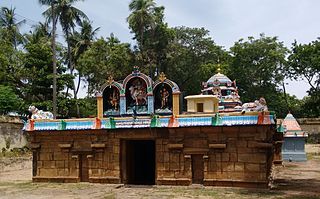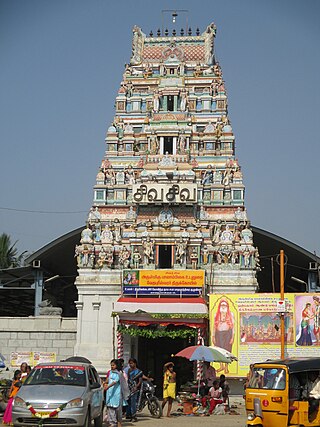
The Vayalur Murugan Temple is a Hindu temple dedicated to Muruga, son of Lord Shiva and Parvati, located in the village of Kumaravayalur in Tiruchirapalli district, Tamil Nadu, India. The temple is believed to have been initiated during the period of Medieval Cholas during the 9th century. The temple is maintained and administered by the Hindu Religious and Charitable Endowments Department of the Government of Tamil Nadu. Though the presiding deity is Shiva, the temple is known for the Murugan shrine. The temple is associated with Hindu savant, Kirupanandha Variyar.

Hara Saabha Vimochana Perumal Temple in Thirukandiyur, a village in the outskirts of Thiruvayaru in the South Indian state of Tamil Nadu, is dedicated to the Hindu god Vishnu. Constructed in the Dravidian style of architecture, the temple is glorified in the Nalayira Divya Prabandham, the early medieval Tamil canon of the Alvar saints from the 6th–9th centuries CE. It is one of the 108 Divya Desam dedicated to Vishnu, who is worshipped as Hara Saabha Vimochana Perumal and his consort Lakshmi as Kamalavalli Nachiyar.

Tiruppukkozhiyur is a Hindu temple dedicated to the deity Shiva, located in Avinasi, a panchayat town in Tiruppur district in the South Indian state of Tamil Nadu. Shiva is worshipped as Avinasiappar, and is represented by the lingam. His consort Parvati is depicted as Karunambigai. The presiding deity is revered in the 7th century Tamil Saiva canonical work, the Tevaram, written by Tamil saint poets known as the Nayanars and classified as Paadal Petra Sthalam.

Kandeeswarar Temple is a Hindu temple dedicated to the god Shiva located in Kandiyur also known as Thirukkandiyur or Tirukkandiyur, near Tiruvaiyaru, Tamil Nadu, India. Shiva is worshiped as Kandeeswarar, and is represented by the lingam and his consort Parvati is depicted as Mangalanayagi. The presiding deity is revered in the 7th century Tamil Saiva canonical work, the Tevaram, written by Tamil poet saints known as the nayanars and classified as Paadal Petra Sthalam. As per legends, Shiva is believed to have destroyed eight different demons and the eight Ashta Veeratanam temples are built signifying each of his victories in the war. The temple is one of the eight where Shiva is believed to have removed one of the five heads of Brahma.

Someswarar Temple is a Hindu temple dedicated to the deity Shiva, located in Kumbakonam, Tamil Nadu, India. Shiva is worshipped as Someswarar and is represented by the lingam. His consort Parvati is depicted as Somasundari. The presiding deity is revered in the 7th century Tamil Saiva canonical work, the Tevaram, written by Tamil saint poets known as the nayanars and classified as Paadal Petra Sthalam.

Sakshinatheswarar Temple or Thiruppurambiyam Temple is a Hindu temple dedicated to the God Shiva located in Thiruppurambiyam, Tamil Nadu, India. Shiva is worshipped as Sakshinathar, and is represented here by a Lingam. His consort, Parvati, is depicted as Ikshuvani. The presiding deity is revered in the 7th century Tamil Saiva canonical work, Thevaram, written by Tamil saint poets, known as the Nayanmaars and classified as Paadal Petra Sthalam.

Chakramangai or Chakravageswarar Temple is a Hindu temple dedicated to Hindu deity Shiva and is located in Chakkarapalli, Papanasam taluk of Thanjavur district, Tamil Nadu, India. The temple is incarnated by the hymns of Thevaram, the 7th century Tamil literature and is classified as Paadal Petra Sthalam. It is one of the 275 Paadal Petra Sthalams, where the three of the most revered Nayanars, Appar and Tirugnana Sambandar have glorified the temple with their verses during the 7th-8th century. The temple has been widely expanded by Chola kings during the 11th century.

Pachaimalai Arulmigu Subramanya Swamy Temple, also known as the Pachaimalai Balamurugan Temple, is one of the two major hill temples located in Gobichettipalayam, Tamil Nadu, India. The temple is dedicated to the Lord Murugan. The temple is constructed in the Tamil style of architecture and is located on top of a small hillock in the outskirts of the town of Gobichettipalayam near Pudupalayam, Tamil Nadu. Here, Kartikeya is venerated as Balamurugan or Subramanya Swamy.

Kodeeswarar Temple(Tamil: :கொட்டையூர் கோடீஸ்வரர் கோயில்) is a Hindu temple dedicated to Lord Shiva, located in Kottaiyur, a village on the western outskirts of Kumbakonam, in Thanjavur district, Tamil Nadu, India. Shiva is worshipped as Koteeswarar and His consort Parvathi as Pandhadu Nayaki. Lord Koteeswarar is revered in the 7th century Tamil Saiva canonical and greatest work, Tevaram, written by Tamil saint poets known as the Nayanmars and classified as Paadal Petra Sthalam, the 275 temples revered in the canon.

Kasi Viswanathar Temple in Sivakasi, a town in Virudhunagar district in the South Indian state of Tamil Nadu, is dedicated to the Hindu god Shiva. Constructed in the South Indian style of architecture, the temple is believed to have been built by Pandyan ruler Harikesari Parakkirama Pandian during the 16th century, with later additions from Madurai Nayaks. Shiva is worshipped as Kasi Viswanathar and his consort Parvathi as Visalakshi. The temple was the scene of temple entry movement in 1899, followed by Sivakasi riots when 22 people were killed.

Kalugasalamoorthy Temple in Kalugumalai, a panchayat town in Thoothukudi district in the South Indian state of Tamil Nadu, is dedicated to the Hindu god Murugan. Constructed in the Dravidian style of architecture, the temple is believed to have been expanded during the 18th century with the images excavated from Kalugumalai. The core temple has a rock-cut architecture exemplary of early Pandyan Art. The other portions of Kalugumalai houses the 8th century Kalugumalai Jain Beds and Vettuvan Koil, an unfinished Shiva temple.

Kolanjiappar temple in Manavalanallur, a village on the outskirts of Virudhachalam in Cuddalore district in the South Indian state of Tamil Nadu, is dedicated to the Hindu god Murugan. Constructed in the Dravidian architecture, the temple is located in the Virudhachalam - Manavalanallur Road. The legend of the temple is associated with Saivite saint Sundarar and the Vriddhagiriswarar temple ad Virudhachalam.

Namakkal Anjaneyar temple is located in Namakkal, a town in Namakkal district in Tamil Nadu, India and is dedicated to the Hindu god Hanuman. It is constructed in the Tamil style of architecture. The legend of the temple is associated with Narasimha, an avatar of Hindu god Vishnu appearing for Hanuman and Lakshmi. The image of Anjaneyar is 18 ft (5.5 m) tall, making it one of the tallest images of Hanuman in India. The temple follows the Vaikhanasa tradition.

The Narasimhaswamy temple in Namakkal, a town in Namakkal district in the South Indian state of Tamil Nadu, is dedicated to the Hindu god Narasimha, an avatar of Vishnu. The temple is one of the 108 Abhimana Kshethrams of Vaishnavate tradition. Constructed in the Dravidian style of architecture and Rock-cut architecture, the temple is located in the Salem–Namakkal–Trichy Road. The legend of the temple is associated with Narasimha, an avatar of Hindu god Vishnu appearing for Lakshmi, his consort, and Hanuman. Based on the architectural features, historians believe that the temple was built during the 6th century by the Adiyamans also called Satyaputras as evident from the inscription mentioning the temple as 'Adiyendra Vishnu Gruham' or 'The house of Vishnu of the Adiyaman kings'.

Kanthaswamy Temple in Cheyyur, in Chengalpattu district in the South Indian state of Tamil Nadu, is dedicated to the Hindu god Murugan. Constructed in the Dravidian style of architecture, the temple was constructed during the Cholas during the 10th century. Murugan is worshipped as Kanthaswamy along with his consorts Valli and Deivasena. A granite wall surrounds the temple, enclosing all its shrines.

Kunnakudi Shanmughanathar temple in Kundrakudi, a village in the outskirts of Karaikudi in Sivaganga district in the South Indian state of Tamil Nadu, is dedicated to the Hindu god Murugan. Constructed in the Hindu style of architecture, the temple is located in the Tirupattur - Karaikudi Road, around 14 km (14,000 m) from Karaikudi. There are three caves located on the western side of the lower rock, that has rock-cut shrines from the Pandyan Empire from the 8th century. The caves have the earliest sculptural representation of Dvarapalas, the guardian deities, for any South Indian temple.

Kripapureeswarar Temple in Thiruvennainallur, a panchayat town in Villupuram district in the South Indian state of Tamil Nadu, is dedicated to the Hindu god Shiva. The presiding deity is revered in the 7th century Tamil Saiva canonical work, the Tevaram, written by Tamil saint poets known as the Nayanmars and classified as Paadal Petra Sthalam. The temple is closely associated with Sundarar, the saivite saint of the 8th century, who started composing his Tirumurai starting with "Pitha Piraisudi" verse in this temple.

Vedapureeswarar Temple is a Hindu temple dedicated to the deity Shiva, located in Thiruverkadu, a Municipality in Tiruvallur district in the South Indian state of Tamil Nadu. Shiva is worshipped as Vedapureeswarar, and is represented by the lingam. His consort Parvati is depicted as Balambigai. The presiding deity is revered in the 7th century Tamil Saiva canonical work, the Tevaram, written by Tamil saint poets known as the Nayanars and classified as Paadal Petra Sthalam.

Karaikandeswarar Temple, Kanji is a Tamil Hindu temple dedicated to the deity Shiva, located in Kanji village near the town of Thiruvannamalai in Tamil Nadu, India. In this temple Shiva is worshiped as Karaikandeswarar, and is represented by the lingam. His consort Parvati is depicted as Periyanayagi Amman.

Kasi Viswanathar Temple in Tenkasi, a city in Tenkasi district in the South Indian state of Tamil Nadu, is dedicated to the Hindu god Shiva. Constructed in the Tamil style of architecture, the temple is believed to have been built by Pandyan ruler Parakrama Pandyan during the 13th century, with later additions from Madurai Nayaks. Shiva is worshipped as Kasi Viswanathar and his consort Parvathi as Ulagamman.





















